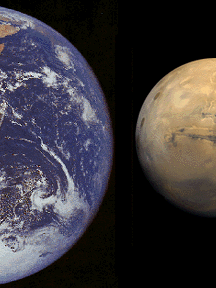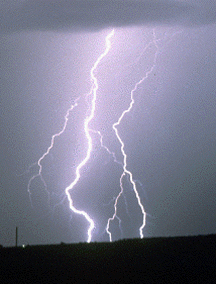This is an image of the Moon showing various minerals found on the surface.
Click on image for full size
NASA
Evidence about the Formation of the Moon
Any successful theory must account for everything we know about the
Moon now. Those things include
- the moon seems to be made of the same material as the Earth's upper mantle.
- the Moon has little or no iron in it, and is composed of material unlike the composition of the Earth as a whole.
- the moon is rounded in shape, like the other planets and not like an asteriod or comet
- the moon orbits in the same direction as the Earth
- the Moon is located in the same plane as the Earth (the ecliptic plane)
- theory suggests that the Moon seems to have drifted away from the Earth over the length of geologic history.
- this means that the Moon was once much closer to the Earth
- this means that the Moon was once bigger in the sky and much brighter than at present
You might also be interested in:

How did life evolve on Earth? The answer to this question can help us understand our past and prepare for our future. Although evolution provides credible and reliable answers, polls show that many people turn away from science, seeking other explanations with which they are more comfortable.
...more
Any successful theory must account for everything we know about the Moon now, as well as make predictions about future observations. There are three theories about how the moon came to be in place: that
...more
Any successful theory must account for everything we know about the Moon now. Those things include the moon seems to be made of the same material as the Earth's upper mantle. the Moon has little or no
...more
Although the Moon does not appear to have a magnetosphere surrounding it, it *is* a magnetic object in space. Scientists think that the magnetism of the Moon's surface is leftover from a time when the
...more
The atmosphere of the Moon may come from a couple of sources, one source is outgassing or the release of gases such as radon, which originate deep within the Moon's interior. Gases are released from the
...more
In decades past is was accepted that the Moon contained no water. Moon rocks collected by Apollo astronauts (at lunar equatorial regions) contained no traces of water. Lunar mapping performed by the Galileo
...more
Here's a safe and easy way to make lightning. You will need a cotton or wool blanket. This experiment works best on a dry, cool night. Turn out all the lights and let your eyes adjust to the darkness.
...more
It takes 3 seconds for sound to travel 1 kilometer (5 seconds to travel 1 mile). The next time a thunderstorm comes your way, look out your bedroom window and watch for lightning. When you see a lightning
...more










